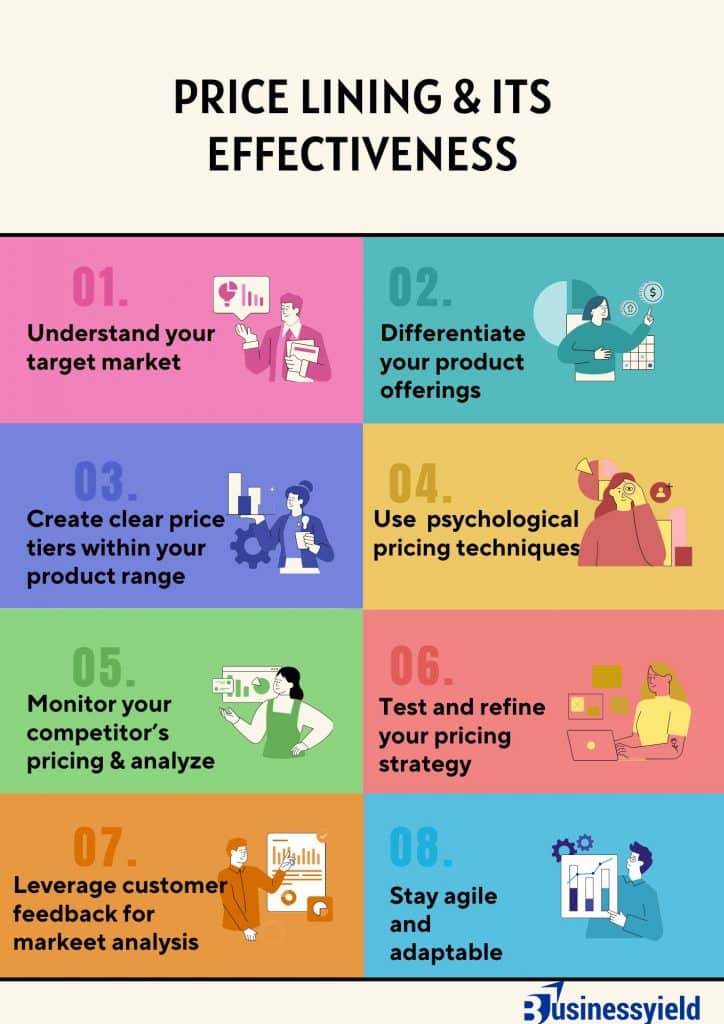Picture yourself entering a clothing store. Imagine going through the catalog of products, which includes everything from basic t-shirts to mid-range casual wear and high-end designer clothing. Each product line is priced differently to cater to customers with varying needs and budgets. With this, customers looking for a basic and affordable option can opt for the t-shirts, while those who want a more stylish and premium product can choose designer clothing. This is the basic premise behind price lining.
There’s no universal template for consumers. They come in all shapes and sizes, with different priorities and preferences. When you release a new product, odds are there won’t be a single, magical strategy or price point you can use to get every prospect excited and on board. This is where price lining comes in, as it can give you the flexibility to appeal to both high- and low-end consumers simultaneously.
Key takeaways
- Price lining is a way to create product lines that target specific consumer groups for increased marketing efficiency.
- Price lining helps companies expand their current customer base by providing multiple pricing options on similar products.
- It is commonly used in e-commerce and retail businesses and helps increase sales and revenue by reaching out to a broader customer base.
- Understanding more about this strategy may help attract more sales of your current goods or services.
Understanding the concept of price lining
Price lining is a marketing strategy that categorizes products or services based on their features and their overall value to customers. This strategy aims to produce higher sales for a company by offering multiple pricing options for similar products. The cost of an item typically begins at a lower range for a more basic model and gets higher as the quality of the product increases.
When companies begin developing a product, they might implement a price-lining strategy for creating product variations that feature different functions to target specific consumer groups. With each variation, companies can change the pricing for the same product while marketing it for its range of features.
Price lining can also be applied to products sold online. E-commerce businesses can use this technique to offer different versions of the same product at different price points. For instance, a software company such as Zendesk may offer three different versions of their software: basic, standard, and premium, each with a different set of features and at different prices. This way, the company can cater to a wide range of customers with varying needs and budgets.
Price lining gives the impression that a product has both budget-friendly, standard options, and premium options with extra features and benefits. It is intended to appeal to both higher-end and value-conscious buyers by giving them a choice between a better product and a better deal.
A company can capture a wide consumer base with the perfect price-lining strategies.
You should read the articles below for a better insight into consumer behavior and how to utilize it for your benefit:
- WHAT IS CONSUMER BEHAVIOR? Types, Characteristics & Theory
- Understanding Consumer Behavior: A Comparative Analysis between Gen Z and Millennials
- CONSUMER MARKET: A Step by Step Guide (All you should know)
How price lining works

Businesses typically adopt price lining to create a perception in the minds of consumers.
First, price differentiation makes consumers choose the product or service they can afford. Second, pricing a product higher than others may lead customers to think the product is of higher value. Releasing more than one version of the same product forms the basis of product line pricing. Businesses often set product prices according to what consumers are willing to pay.
Typically, a company produces three different versions of the same product and brands the products as basic, average, and premium versions. The basic version is affordable but has fewer features, while the average version has more features and, therefore, is priced higher. The premium version often has all the features of the basic and average versions, plus additional features. This attracts higher prices for premium products.

With this, it is up to consumers looking to buy from this product line to decide how much money they can afford to pay and the features they want in the product.
Price lining strategy
Price lining rests upon creating the perception of premium quality—the idea that a higher price point should mean a higher caliber product.
Your more costly product or service must have enough additional features or benefits to set it apart from its cheaper competitors. Buyers interested in the premium model must believe that their money is going towards a fundamentally superior product or service. This means providing actual enhancements to important components, rather than just more bells and whistles.
For instance, the iPhone 11 Pro has longer battery life and a more powerful processor than the regular iPhone 11—not just extra, more superficial features like additional cameras.
You also need to be mindful of pricing when price lining, as you want to be able to appeal to two different kinds of buyers: those who prioritize value and those who prefer quality. That means setting two separate prices that are different enough from one another to appeal to both sides. If you’re pricing a new gaming console with a premium model that costs $510 and a standard model that costs $500, it will seem like you’re offering two borderline indistinguishable options. You might miss out on both high-end buyers willing to pay considerably more for a premium model and budget-conscious buyers who won’t see your standard model as much of a bargain.
READ: PRICING STRATEGIES MARKETING: Definition, Types & How to Choose
That being said, if your high-end model or service is outrageously overpriced, buyers may see it as frivolous or unnecessary. Products and services are only worth what people are willing to pay for them. This is what you need to understand when setting your price points.
I have attached a checklist below containing the steps you can follow to develop a winning price lining strategy for your business:
BusinessYield price lining strategy
Price lining examples
Here are some examples of product line pricing to help you understand how this strategy works:
#1. Smartphones
Smartphone pricing is a typical example of a product line pricing strategy, as manufacturers produce different versions of the same phone with differentiated features. For instance, the basic version of smartphone A can have a smaller display screen, with B and C versions having larger screens. Other features, such as camera resolution and memory size, may also differ across smartphones.
In addition, smartphone makers often release additional features at intervals to keep customers within the product line.
#2. Mobile data services
Internet service providers sell data to consumers depending on how much they can afford to pay. Typically, data users subscribe to different data packages daily, weekly, or monthly. By using this pricing strategy, data companies serve different customer segments, such as occasional browsers, medium data users, and heavy data consumers, such as companies.
#3. Automobiles
Carmakers produce different versions of the same car model to attract and keep customers within the brand. The basic trim levels usually come with fewer features than the higher trim levels. Differentiated features across the trim levels can include safety features, heated seats, in-car technology, and infotainment features.
With this, car buyers on a budget can opt for the basic trim level while staying within their preferred carmaker rather than purchasing a different car from another company.

#4. Online learning courses
Companies offering online courses can have a product pricing strategy for their courses. For instance, learners taking the basic course can access the learning materials without downloading the content. Learners on the higher-priced option can access the materials, download the content for offline access, and qualify for a certificate upon completion.
Differentiating the price and features allows more learners to access the content while enabling the company to earn revenue.
#5. Internet security solutions
Companies providing internet security solutions typically create different versions of their products to cater to their diversified customer segments. For instance, individual device users can purchase basic antivirus software, while small businesses can purchase antivirus software with additional features, such as installing the software on multiple devices.
Premium buyers may get additional benefits, such as a password manager, malware identification capabilities, and enhanced virus detection.
#6. Hotels
A hotel can price its rooms differently to attract a wider customer base. For instance, hotel owners can price hotel rooms without premium facilities, such as a sauna or Wi-Fi, lower than rooms with these features. The size and location of the room can also be a differentiating factor.
For example, hotel rooms overlooking a beach can attract higher charges than an ordinary room located elsewhere in the building.
#7. Consumables
Consumables like shavers can also have a product line pricing strategy. A one-use shaver can be priced lower than a shaver with replaceable blades. A consumer on a budget or with other spending priorities can opt for the one-use shaver and shift to the replaceable blades when the budget allows.
Advantages of price lining
Apart from offering purchasing value to consumers, price lining has several other advantages. Pricing products or services using this method offers companies higher profits without requiring a high investment. Rather than focusing on offering several different products, marketers can focus on a single brand, which lowers advertising costs, labor costs, and overhead.
Below are the major advantages of implementing price lining strategies in your business:
#1. Pricing
When developing a product, you should consider the cost of production, product features, and competitor businesses to determine a suggested retail price for consumer sales. A price-lining strategy with one base product can make pricing decisions easier than setting a pricing strategy for a set of different products altogether.
Setting the price differences based on features and quality will help you add a sense of value while establishing a diverse consumer base for those with different financial or personal needs.
ALSO READ: PRICING STRATEGY: Best Strategies to Maximize Profit
#2. Presentation
A product lineup presents consumers with the range of product variations available to demonstrate each variation’s specific features and price points. This allows consumers to create direct comparisons between each variation and determine which one best suits their product needs or wants.
Presenting the available product values shows the consumer the value of the additional feature. It can also encourage them to buy a higher-priced item for its quality.
#3. Production
You can monitor the performance of each product variation to compare which ones generate the highest returns on investment. Using this insight, you might choose to discontinue a specific item in your lineup to reduce production costs.
Removing an item from the production lines can save resources, reduce costs, and increase profit margins for overall improved company performance.
#4. Profits
Along with reducing production costs, price lining can help you optimize external marketing and advertising resources by minimizing the need for them. A price-lining strategy can effectively market a product to different audiences in one product advertisement or campaign, rather than several, separate campaigns for each item.
Doing this can further improve your profit margins while increasing sales performance.
#5. Purchases
When retail stores display a product lineup, they organize them according to their product category and price-lining specifications. The visual representation of the products allows customers to visually understand the value of the pricing differences in the product features and quality.
With the products organized in this way, customers will have an easier time identifying the product they need. This also helps make the purchasing decision easier, even without recommendations from a sales associate.
Disadvantages of price lining
Here are the drawbacks of price lining to consider when developing sales strategies and solutions:
#1.Fluctuation
The economy and product markets may change without notice and create inflation. This can create a disadvantage for the higher-priced products in a lineup and result in an overstock of inventory. These fluctuations may be a challenge to predict, but you can prepare for potential changes when developing a product and its pricing strategies to minimize the effect of market fluctuations.
#2. Focus
Price lining is a strategy only focused on pricing. This more narrow focus allows it to be as accurate as possible for its purposes but may narrow product development efforts based on the price of the result. It’s important to consider market trends, consumer behavior, and the economic climate throughout the entire production process.
#3. Forecasting
Forecasting a product’s performance is an important part of developing sales goals, return on investment analysis and consumer engagement strategies. Price lining’s focus on price alone can hinder forecasting accuracy and outcomes. Regularly evaluate historical, current, and competitive performance to develop thorough forecasting reports and plans for product updates or new developments.
Price lining in e-commerce and retail
In e-commerce and retail businesses, price lining can impact pricing in the following ways:
- Cost-based pricing. Businesses can use cost-based pricing, where prices are set based on the costs of production, to determine the appropriate price point for different products or product lines.
- Product differentiation. Businesses can use price lining to differentiate their products and create perceived value in the minds of consumers.
- Market segmentation. Businesses can use price lining to segment the market and create different pricing strategies for different groups of consumers.
- Profit maximization. Businesses can use price lining to maximize profits by charging higher prices for higher-margin products and lower prices for lower-margin products.
- Price optimization. Businesses can use price optimization techniques, such as dynamic pricing, to adjust prices in real-time based on market conditions and consumer demand.
- Price anchoring. Businesses can use price anchoring, where they set a higher price for a product and then offer a discounted price, to create the perception of a better deal for consumers.
Conclusion on price lining
Price lining is a powerful tool that can be used by e-commerce and retail businesses to segment the market, differentiate products, maximize profits, and create the perception of a better deal for consumers. It helps businesses to make the right pricing decisions and attracts different groups of consumers.
By offering basic, mid-range, and premium products, businesses can effectively cater to customers with different needs and budgets, thereby increasing their sales and revenue.






